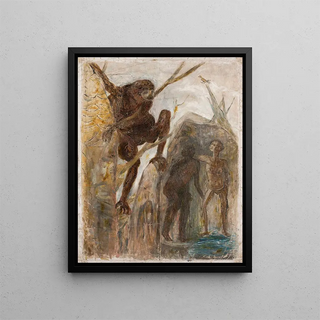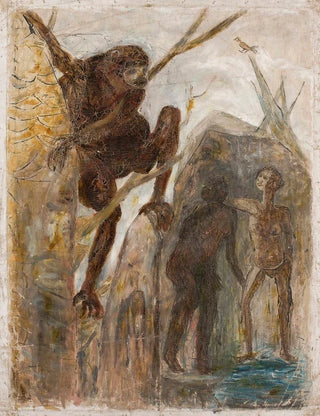Art print | Landscape with a Monkey - Tadeusz Makowski


View from behind

Frame (optional)
In the rich and complex universe of art, certain works manage to capture the essence of humanity while evoking the beauty of the natural world. "Art print Landscape with a Monkey - Tadeusz Makowski" is one of these creations that transcends simple representations to offer an immersive visual experience. This painting, both enigmatic and captivating, transports us to a universe where nature and wildlife meet, revealing the subtleties of the interaction between man and his environment. Makowski, with his unique approach, manages to establish a dialogue between the viewer and the canvas, inviting each to explore the emotions and reflections his work evokes.
Style and uniqueness of the work
Tadeusz Makowski's style is distinguished by a delicate harmony between color and form. In "Landscape with a Monkey," one can observe a palette of vibrant colors that evoke both joy and melancholy. Shades of green, blue, and earth tones blend to create a lush landscape, while the presence of the monkey, with its curious and expressive gaze, adds a touch of humanity to this natural scene. The composition is carefully orchestrated, each element placed with precision that testifies to the undeniable talent of the artist. This painting does not merely depict a landscape; it tells a story, that of a harmonious coexistence between living beings. Makowski, through his distinctive style, manages to capture the fleeting moment when nature and animality meet, inviting the viewer to contemplate this union.
The artist and his influence
Tadeusz Makowski, Polish artist of the early 20th century, made his mark on his era with his innovative vision and commitment to representing nature. Influenced by the artistic currents of his time, notably Fauvism and Expressionism, Makowski developed a style that is uniquely his own, characterized by stylized forms and bold colors. His work stands at the crossroads between tradition and modernity, offering a unique perspective on the world around him. By incorporating elements of Polish folklore and motifs

Matte finish

View from behind

Frame (optional)
In the rich and complex universe of art, certain works manage to capture the essence of humanity while evoking the beauty of the natural world. "Art print Landscape with a Monkey - Tadeusz Makowski" is one of these creations that transcends simple representations to offer an immersive visual experience. This painting, both enigmatic and captivating, transports us to a universe where nature and wildlife meet, revealing the subtleties of the interaction between man and his environment. Makowski, with his unique approach, manages to establish a dialogue between the viewer and the canvas, inviting each to explore the emotions and reflections his work evokes.
Style and uniqueness of the work
Tadeusz Makowski's style is distinguished by a delicate harmony between color and form. In "Landscape with a Monkey," one can observe a palette of vibrant colors that evoke both joy and melancholy. Shades of green, blue, and earth tones blend to create a lush landscape, while the presence of the monkey, with its curious and expressive gaze, adds a touch of humanity to this natural scene. The composition is carefully orchestrated, each element placed with precision that testifies to the undeniable talent of the artist. This painting does not merely depict a landscape; it tells a story, that of a harmonious coexistence between living beings. Makowski, through his distinctive style, manages to capture the fleeting moment when nature and animality meet, inviting the viewer to contemplate this union.
The artist and his influence
Tadeusz Makowski, Polish artist of the early 20th century, made his mark on his era with his innovative vision and commitment to representing nature. Influenced by the artistic currents of his time, notably Fauvism and Expressionism, Makowski developed a style that is uniquely his own, characterized by stylized forms and bold colors. His work stands at the crossroads between tradition and modernity, offering a unique perspective on the world around him. By incorporating elements of Polish folklore and motifs






